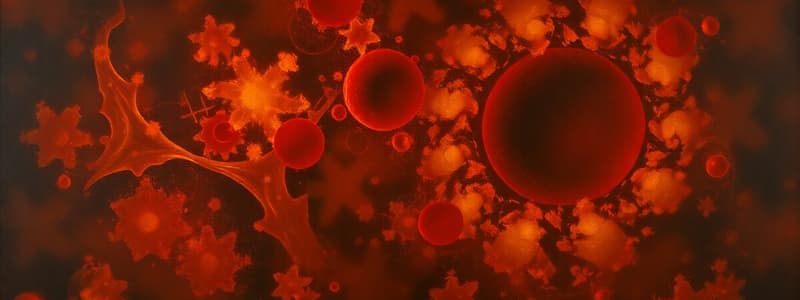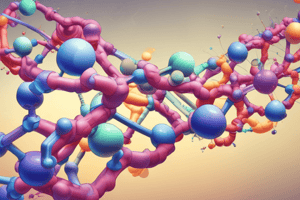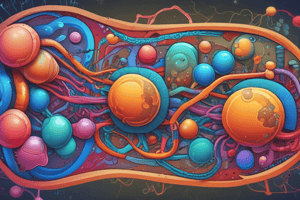Podcast
Questions and Answers
In chemiosmotic theory, what drives the phosphorylation of ADP to ATP?
In chemiosmotic theory, what drives the phosphorylation of ADP to ATP?
- The hydrolysis of ATP within the intermembrane space
- The flow of electrons down the electron-transfer chain
- The oxidation of NADH and FADH2
- The flow of protons down the electrochemical gradient (correct)
What is the primary role of the proteins embedded within the inner mitochondrial membrane regarding ATP synthesis?
What is the primary role of the proteins embedded within the inner mitochondrial membrane regarding ATP synthesis?
- To directly phosphorylate ADP using substrate-level phosphorylation
- To synthesize NADH and FADH2 for use in the citric acid cycle
- To facilitate the diffusion of protons, eliminating the electrochemical gradient
- To couple the 'downhill' flow of electrons with the 'uphill' flow of protons across the membrane (correct)
How does the energy derived from the catabolism of sugars, fats, and amino acids contribute to ATP synthesis?
How does the energy derived from the catabolism of sugars, fats, and amino acids contribute to ATP synthesis?
- It is used to create an electrochemical potential by pumping protons across the inner mitochondrial membrane. (correct)
- It activates the ATP synthase enzyme complex.
- It directly phosphorylates ADP to form ATP via substrate-level phosphorylation.
- It facilitates the transport of ATP out of the mitochondrial matrix.
What is the effect of the cristae on the inner mitochondrial membrane?
What is the effect of the cristae on the inner mitochondrial membrane?
How do the electrons from NADH and FADH2 contribute to ATP synthesis in oxidative phosphorylation?
How do the electrons from NADH and FADH2 contribute to ATP synthesis in oxidative phosphorylation?
Which of the following is NOT a characteristic of the inner mitochondrial membrane?
Which of the following is NOT a characteristic of the inner mitochondrial membrane?
What is the role of mobile electron carriers such as Coenzyme Q in the electron transport chain?
What is the role of mobile electron carriers such as Coenzyme Q in the electron transport chain?
How does the transfer of electrons from NADH to ubiquinone contribute to the proton gradient?
How does the transfer of electrons from NADH to ubiquinone contribute to the proton gradient?
Which property of ubiquinone (coenzyme Q) allows it to function effectively within the electron transport chain?
Which property of ubiquinone (coenzyme Q) allows it to function effectively within the electron transport chain?
What is the role of the iron-sulfur (Fe-S) clusters present in the electron transport chain?
What is the role of the iron-sulfur (Fe-S) clusters present in the electron transport chain?
What distinguishes cytochromes from other electron carriers in the electron transport chain?
What distinguishes cytochromes from other electron carriers in the electron transport chain?
Which of the following properties makes ubiquinone (coenzyme Q) ideally suited to its function in the electron transport chain?
Which of the following properties makes ubiquinone (coenzyme Q) ideally suited to its function in the electron transport chain?
How does the Q cycle in Complex III contribute to the generation of a proton gradient?
How does the Q cycle in Complex III contribute to the generation of a proton gradient?
What determines the sequence of electron transfer in the electron transport chain?
What determines the sequence of electron transfer in the electron transport chain?
What is the role of Complex I in the electron transport chain?
What is the role of Complex I in the electron transport chain?
What is the primary function of Complex IV (cytochrome oxidase) in the electron transport chain?
What is the primary function of Complex IV (cytochrome oxidase) in the electron transport chain?
How does Complex II (succinate dehydrogenase) differ from other complexes in the electron transport chain?
How does Complex II (succinate dehydrogenase) differ from other complexes in the electron transport chain?
How do uncoupling agents like dinitrophenol (DNP) affect ATP synthesis and oxygen consumption?
How do uncoupling agents like dinitrophenol (DNP) affect ATP synthesis and oxygen consumption?
What is the role of the c-ring in ATP synthase?
What is the role of the c-ring in ATP synthase?
How is the electrochemical gradient generated by the electron transport chain coupled to ATP synthesis by ATP synthase?
How is the electrochemical gradient generated by the electron transport chain coupled to ATP synthesis by ATP synthase?
What is the effect of inhibiting the electron transport chain on the production of reactive oxygen species (ROS)?
What is the effect of inhibiting the electron transport chain on the production of reactive oxygen species (ROS)?
How do the malate-aspartate shuttle and glycerol-3-phosphate shuttle systems facilitate oxidative phosphorylation?
How do the malate-aspartate shuttle and glycerol-3-phosphate shuttle systems facilitate oxidative phosphorylation?
What is the role of the 'a' subunit in the F0 complex of ATP synthase in coupling proton flow to ATP synthesis?
What is the role of the 'a' subunit in the F0 complex of ATP synthase in coupling proton flow to ATP synthesis?
In the binding-change model, how is the energy derived from proton translocation converted into the chemical energy of ATP?
In the binding-change model, how is the energy derived from proton translocation converted into the chemical energy of ATP?
What role does the matrix pH play in regulation of oxidative phosphorylation?
What role does the matrix pH play in regulation of oxidative phosphorylation?
What is the significance of the malate-aspartate shuttle system in eukaryotic cells?
What is the significance of the malate-aspartate shuttle system in eukaryotic cells?
How does the glycerol-3-phosphate shuttle facilitate the process of oxidative phosphorylation?
How does the glycerol-3-phosphate shuttle facilitate the process of oxidative phosphorylation?
What is the role of the adenine nucleotide translocase in oxidative phosphorylation?
What is the role of the adenine nucleotide translocase in oxidative phosphorylation?
How does the number of protons influences the rotation of the Fo subunit in ATP synthase to the ATP product?
How does the number of protons influences the rotation of the Fo subunit in ATP synthase to the ATP product?
Inhibiting complex IV halts electron transport in oxidative phosphorylation. Which event does the inhibitor, cyanide, block?
Inhibiting complex IV halts electron transport in oxidative phosphorylation. Which event does the inhibitor, cyanide, block?
What is the mechanistic function of Uncoupling Protein 1 (UCP-1), also known as Thermogenin?
What is the mechanistic function of Uncoupling Protein 1 (UCP-1), also known as Thermogenin?
How does the adenine nucleotide translocase (ANT) contribute to the regulation of oxidative phosphorylation?
How does the adenine nucleotide translocase (ANT) contribute to the regulation of oxidative phosphorylation?
What is the main purpose of proton wires in the context of NADH:Ubiquinone Oxidoreductase’s role as a proton pump?
What is the main purpose of proton wires in the context of NADH:Ubiquinone Oxidoreductase’s role as a proton pump?
What is the impact of the fact that a small portion of electrons transported through the electron transport chain react with oxygen to create superoxide radicals?
What is the impact of the fact that a small portion of electrons transported through the electron transport chain react with oxygen to create superoxide radicals?
What is the advantage of the close arrangement of electron-transfer complexes into a respirasome?
What is the advantage of the close arrangement of electron-transfer complexes into a respirasome?
How is the electrochemical gradient harnessed in plants' thylakoids?
How is the electrochemical gradient harnessed in plants' thylakoids?
If a mutation caused Complex II to pump protons, what effect would that have on the PMF?
If a mutation caused Complex II to pump protons, what effect would that have on the PMF?
What are the structural features most essential to directional proton pumping by the membrane stator?
What are the structural features most essential to directional proton pumping by the membrane stator?
What is the consequence of the direct interaction between the membrane-bound rotor of ATP synthase and the membrane stator?
What is the consequence of the direct interaction between the membrane-bound rotor of ATP synthase and the membrane stator?
How does the malate-aspartate shuttle circumvent the inner mitochondrial membrane's impermeability to NADH, facilitating oxidative phosphorylation?
How does the malate-aspartate shuttle circumvent the inner mitochondrial membrane's impermeability to NADH, facilitating oxidative phosphorylation?
How does the precise coordination of iron and sulfur atoms within iron-sulfur clusters contribute to the function of the electron transport chain?
How does the precise coordination of iron and sulfur atoms within iron-sulfur clusters contribute to the function of the electron transport chain?
How does the action of uncoupling proteins like UCP-1 (thermogenin) result in heat generation?
How does the action of uncoupling proteins like UCP-1 (thermogenin) result in heat generation?
During oxidative phosphorylation, if the pH in the mitochondrial matrix increases and becomes more alkaline, how would the ATP synthesis be affected, assuming no other regulatory mechanisms compensate?
During oxidative phosphorylation, if the pH in the mitochondrial matrix increases and becomes more alkaline, how would the ATP synthesis be affected, assuming no other regulatory mechanisms compensate?
Flashcards
ATP synthase
ATP synthase
Hydrolyzes transmembrane H+ gradient to produce ATP.
Electrochemical potential
Electrochemical potential
A gradient of electrochemical potential, typically of protons, across a membrane.
Oxidative phosphorylation
Oxidative phosphorylation
Process uses energy extracted in the form of NADH and FADH2 to create an electrochemical potential.
Outer mitochondrial membrane
Outer mitochondrial membrane
Signup and view all the flashcards
Inner mitochondrial membrane
Inner mitochondrial membrane
Signup and view all the flashcards
Mitochondrial matrix
Mitochondrial matrix
Signup and view all the flashcards
Coenzyme Q (Ubiquinone)
Coenzyme Q (Ubiquinone)
Signup and view all the flashcards
Flavin mononucleotide (FMN)
Flavin mononucleotide (FMN)
Signup and view all the flashcards
Iron-sulfur centers
Iron-sulfur centers
Signup and view all the flashcards
Flavin adenine dinucleotide (FAD)
Flavin adenine dinucleotide (FAD)
Signup and view all the flashcards
Complex III
Complex III
Signup and view all the flashcards
Cytochrome c
Cytochrome c
Signup and view all the flashcards
Complex IV (Cytochrome oxidase)
Complex IV (Cytochrome oxidase)
Signup and view all the flashcards
Four electrons (Complex IV)
Four electrons (Complex IV)
Signup and view all the flashcards
Rotenone
Rotenone
Signup and view all the flashcards
Q cycle
Q cycle
Signup and view all the flashcards
Respirasome
Respirasome
Signup and view all the flashcards
Reactive Oxygen Species (ROS)
Reactive Oxygen Species (ROS)
Signup and view all the flashcards
Electron transport (PMF)
Electron transport (PMF)
Signup and view all the flashcards
Proton translocation
Proton translocation
Signup and view all the flashcards
Translocases
Translocases
Signup and view all the flashcards
Inhibitor of F1 (IF1)
Inhibitor of F1 (IF1)
Signup and view all the flashcards
Malate-aspartate shuttle
Malate-aspartate shuttle
Signup and view all the flashcards
Glycerol-3-phosphate shuttle
Glycerol-3-phosphate shuttle
Signup and view all the flashcards
Study Notes
Energy Flow in Cellular Respiration
- Carbohydrates, lipids, and amino acids are the main reduced fuels for the cell
- Electrons from reduced fuels are transferred to reduced cofactors NADH or FADH2
- Oxidative phosphorylation uses the energy from NADH and FADH2 to make ATP
Chemiosmotic Theory
- Formation of ATP from ADP and Pi is thermodynamically unfavorable
- Energy to phosphorylate ADP is provided by the flow of protons down the electrochemical gradient
- Electron transport releases energy to transport protons against the electrochemical gradient
Chemiosmotic Energy Coupling and Membranes
- A proton gradient is needed for ATP synthesis, established across a membrane impermeable to ions
- Plasma membranes in bacteria, inner membranes in mitochondria, and thylakoid membranes in chloroplasts
- Membranes contain proteins that couple the downhill flow of electrons in the electron-transfer chain with the uphill flow of protons
- Membranes contain a protein that couples the downhill flow of protons to the phosphorylation of ADP
Mitochondrial Membranes
- The outer membrane is relatively porous and allows passage of metabolites.
- The intermembrane space (IMS) has a similar environment to the cytosol, with a higher proton concentration (lower pH)
- The inner membrane is relatively impermeable, with a proton gradient and the electron transport chain complexes, convolutions called cristae increase the surface area
- The matrix is the location of the citric acid cycle and parts of lipid and amino acid metabolism and a lower proton concentration (higher pH)
Electron Transport Chain
- There is a series of electron carriers with multiple redox centers
Electron Transfer Order
- The order of transfer of electrons depends on reduction potential
- AG = -n F Δεo
- NADH + H+ +1/2 O2→ NAD+ + H2O
- ΔG = - 2×96500 × {0.817- (-0.32)} ≈ - 220 kJ/mol
ETC Co-factors
- Coenzyme Q, flavin mononucleotide (FMN), flavin adenine dinucleotide (FAD), porphyrin, and iron-sulfur clusters are co-factors
NADH
- The TCA cycle and fatty acid β-oxidation provide electrons for NAD+ reduction
- Only two electrons can be taken up or released at a time
FMN and FAD
- Can be covalently bound to proteins
- Act to distribute electrons. Accept two electrons from carriers unstable with single electrons, then donate one electron at a time to acceptors that can only accept single electrons
Cytochromes
- Cytochromes are one-electron carriers
- They have iron-coordinating porphyrin ring derivatives
- Cytochromes a, b, and c differ by ring additions
Iron-Sulfur Clusters
- Iron-sulfur clusters are one-electron carriers
- Contain cysteines and equal numbers of iron and sulfur atoms
Coenzyme Q (Ubiquinone)
- Accepts electrons readily
- It is a lipid-soluble conjugated dicarbonyl compound
- Ubiquinone picks up two protons to give an alcohol, or ubiquinol Ubiquinol can freely diffuse in the membrane, carrying electrons with protons from one side to the other
- Transfers electrons from Complexes I and II to Complex III
Protein components of mitochondrial respiratory chain
- Complex I (NADH dehydrogenase): 850 kDa, 45 (14) subunits, prosthetic groups FMN and Fe-S
- Complex II (Succinate dehydrogenase): 140 kDa, 4 subunits, prosthetic groups FAD and Fe-S
- Complex III (Ubiquinone: cytochrome c oxidoreductase): 250 kDa, 11 subunits, prosthetic groups Hemes and Fe-S
- Cytochrome c: 13 kDa, 1 subunit, prosthetic group Heme, moves between Complexes III and IV as a freely soluble protein
- Complex IV (Cytochrome oxidase): 204 kDa, 13 (3-4) subunits, prosthetic groups Hemes, CUA and CUB
NADH: Ubiquinone Oxidoreductase (Complex I)
- Is one of the largest macro-molecular assemblies in the mammalian cell
- It has over 40 different polypeptide chains, encoded by both nuclear and mitochondrial genes
- It's NADH binding site is on the matrix side
- A noncovalently bound flavin mononucleotide (FMN) accepts two electrons from NADH.
- Iron-sulfur centers pass one electron at a time toward the ubiquinone binding site
NADH: Ubiquinone Oxidoreductase as Proton Pump
- Two electrons from NADH are transferred to ubiquinone
- Protons are transferred from the matrix (N) to the intermembrane space (P)
- Four protons are transported per one NADH: NADH + Q + 5H+N = NAD+ + QH2 + 4 H+P
- Reduced coenzyme Q picks up two protons
- Protons are transported by proton wires (a series of amino acids)
Complex I and Redox State
- Electron flow changes the redox state of the protein complex, inducing conformational changes
- Long-range conformational changes alter the transmembrane helices. The oxidation/reduction cycle of coenzyme Q is linked to this process
- Quinone binding induces a conformational change needed for its reduction
- When QH2 is formed and released, all 4 H+ are pumped in one stroke from a single subunit
Succinate Dehydrogenase (Complex II)
- It does not transport protons
- Accepts two electrons from succinate
- Electrons are passed, one at a time, to ubiquinone
- It contains iron-sulfur centers to QH2.
- It's the same enzyme in TCA
Complex II and Electron Transfer
- Distance for the electron to travel is 40 Angstroms
- Fe-S cluster centers are less than 14 Angstroms apart
- 1 electron goes from FADH2 to Fe-S to coenzyme Q at a time
- 2 Hydrogens go to Q from water
- Role of heme is unknown, one hypothesis is it acts as an electron sink to prevent the formation of reactive oxygen species
Ubiquinone: Cytochrome c Oxidoreductase (Complex III)
- Complex III reduces two molecules of cytochrome c using two electrons from QH2
- It conttains iron-sulfur clusters, cytochrome b, and cytochrome c
- Four additional protons are translocated to the intermembrane space
- Translocation is facilitated by via the Q-cycle
The Q Cycle
- Four protons are transported across the membrane per two electrons which reach cytochrome c
- Two of the four protons come from the first incoming QH2
- Electrons travel on split pathways to the P and N side
- The Q cycle explains how two additional protons are picked up from the matrix
- One second molecule of QH₂ becomes oxidized
- Protons release into the IMS A molecule becomes reduced regenerating a QH2, picking up protons from the matrix side. Thus a net transfer of four protons passes per reduced coenzyme Q
Cytochrome c
- A soluble heme-containing protein in the intermembrane space
- Heme iron can be either ferrous (Fe3+, oxidized) or ferric (Fe2+, reduced)
- Second mobile electron carrier, (ubiquinone moves through the membrane)
- Cytochrome c carries a single electron from the cytochrome bc1 complex to cytochrome oxidase
- Ancient protein that is highly conserved
Cytochrome Oxidase (Complex IV)
- Mammalian cytochrome oxidase is a membrane protein with 13 subunits
- Contains two heme groups: a and a3
- Contains copper ions: Сид (two that accept electrons from cyt c) and CuB (bonded to heme a3, forming a binuclear center)
Cytochrome Oxidase (Complex IV) and Electrons
- Four electrons are used to reduce one oxygen molecule into two water molecules
- Four protons are picked up from the matrix in theis process
- An additional four protons are passed from the matrix to the intermembrane space.
Summary of Electron Flow
- For Complex I to Complex IV yields: 1NADH + 11H+(N) + ½O2 yields NAD+ + 10H+(P) + H2O
Summary of transport
- For Complex I to Complex IV: 1NADH + 11H+(N) + ½O2 yields NAD+ + 10H+(P) + H2O
- For Complex II to Complex IV: FADH2 + 6H+(N) + ½O2 yields FAD + 6H+(P) + H2O
- The difference in the number of protons transported reflects differences in ATP synthesized.
Respirasome
- Respirasomes are usually made of complexes I, III, and IV Complex II does not interact and moves freely in the membrane (TCA enzyme)
Chemiosmotic Model for ATP Synthesis
- Electron transport sets up a proton-motive force (PMF)
- A direct pump removes H from Q and forms water
- Energy of proton-motive force drives synthesis of ATP
Calculating G
- The pH of the matrix is 7.8 while is 7 in the intermembrane space
- The transmembrane potential drops by 0.15 V
- ΔG = 8.314 ×298 ×ln (1.6 ×10-8 / 10-7 ) + (+1)×96500 ×(-0.15) = -19000 J/mol = -19 kJ/mol
40 For 10 protons passing back into the matrix, -190 kJ/ mol is released. The oxidation of NADH results in 220 kJ/mol of free energy. The pumping of protons has captured the free energy.
ATP-coupled electron transport in mitochondria
- ADP and Pi alone are by themselves not enough to drive ATP synthesis
- CN- (cyanide) prevents electrons passing to O2 through binding to complex IV, therefore halting O₂ consumption and ATP synthesis
- Uncouplers (like DNP) halt ATP synthesis but do not affect O₂ consumption, by freely allowing protons to cross the membrane
Mitochondrial ATP Synthase Complex
- Contains two functional units: F1 and F0
- F1 is a soluble complex in the matrix that individually catalyzes the hydrolysis of ATP
- F0 is an integral membrane complex that transports protons from IMS to matrix, dissipating the proton gradient, therefore energy is transferred to F1 to catalyze phosphorylation of ADP
F1 - Synthesizing ATP
- A hexamer is arranged from three αβ dimers
- Dimers can exist in three different conformations:
- Open: empty
- Loose: binds ADP and Pi
- Tight: catalyzes ATP formation, and binds product
Coupling Proton Translocation to Synthesis
- Proton translocation causes a rotation of the F0 subunit and the central shaft γ
- This causes a conformational change within all the three αβ pairs
- The conformational change promotes condensation of ADP and P₁ into ATP
Transport of ADP and P₁ into the Matrix
- Translocation of a fourth proton per ATP is required to facilitate cotransport of substrates into and products out of the mitochondria
ATP by Oxidation of Glucose
- In prokaryotes, organelles do not segregate machinery, so all electron carriers can directly feed into the electron-transport chain In eukaryotes, segregation prevents NADH from the cytosol from directly entering the electron-transport chain at Complex I
- NAD+ pools don't directly cross mitochondrial inner membrane
- Electrons from NADH from the cytosol are fed into the mitochondria with two methods: malate-aspartate shuttle and glycerol-3-phosphate shuttle
Regulation of Oxidative Phosphorylation
- Primarily regulated by substrate availability of NADH and ADP/Pi
- Controlled by inhibitor of F1 (IF1)
- Prevents hydrolysis of ATP during low oxygen
- Only active at lower pH, when electron transport stalls (i.e., low oxygen)
Inhibition of OxPhos is used for:
- Feedback loops of accumulation of NADH
- Feedback inhibition cascade up to PFK-1
Uncoupling Synthesis from ETC
- Uncoupling protein 1 (UCP-1) uncouples synthesis generate heat
- Seen hibernating animals and babies
Studying That Suits You
Use AI to generate personalized quizzes and flashcards to suit your learning preferences.




